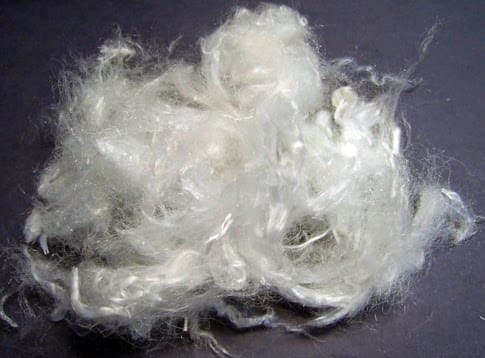Both acrylic and modacrylic fibres are generally referred to as acrylic fibres, unless the context requires further classification. Where appropriate, distinctions in properties or end uses between acrylics and modacrylics are indicated.
Acrylic and modacrylic fibres are produced from acrylonitrile, a petrochemical but they have some differences as follows :
Difference Between Acrylic and Modacrylic Fibre
| Sr. No. | Acrylic | Mod Acrylic |
| 1 | Acrylic fibre has more than 85% acrylonitrile units. | The units of acrylonitrile in the Mod Acrylic vary between 35 to 85%. |
| 2 | Acrylic has lower specific gravity. | Mod Acrylic has higher specific gravity than Acrylic |
| 3 | The Acrylic fibre begins to soften at 4500 – 5000 F. | The Mod Acrylic begins to soften at 500 – 1000 F. |
| 4 | The Acrylic fibre can be heat set & texturized. | Mod Acrylic can’t be heat set & texturized. |
| 5 | Acrylic does not have self extinguish flame behaviour. | Mod Acrylic has self extinguish flame behaviour. |
| 6 | The specific gravity of Acrylic fibre is 1.17 gms/cc. | The specific gravity of Mod Acrylic fibre is nearly 1.35 gms/cc. |
| 7 | High tenacity ( is 2–3.5 g/d) | A very low tenacity |
| 8 | Moisture regain is 1–2 percent | Typical moisture regain is 3.5% |
| 9 | Acrylic fibre materials are quick drying. | Comparatively Modacrylic fibre dry more quickly |
| 10 | Acrylic fibres recover well from small amounts of stretching | Low softening temperatures of modacrylic fibres allow them to be stretched, embossed and moulded into special shapes |
| 11 | Acrylic fibres are more suited for processing into high bulky yarns | Mod Acrylic fibres are comparatively less suitable for processing into high bulky yarns |
| 12 | Acrylic fibre has a good resistance to moths, mildew, mineral acids, and chemical substances. The resistance to weak alkalise is fairly good, while hot strong alkalies rapidly attack acrylic fibre | Modacrylic fibres have outstanding resistance to many chemicals and solvents, and are not attacked by moths and mildew. |
| 13 | Acrylic fibre have high resistance to damage by abrasion | Modacrylic fibres have a moderate resistance to abrasion
|
| 14 | Highly resistant to sunlight | Excellent resistance to sunlight |
| 15 | Types of Acrylic fibre
Orlon, Acrylian, Creslan and Zefran |
Types of Modacrylic fibre
Dynel and Verel |
Although from the above difference they have some similar properties also.
Acrylic fibres have round or moderately irregular cross sections typically characterized as bean, dog-bone, or peanut shaped. Both Acrylic and Modacrylic fibres have good dimensional stability.
The variable chemical units in the fibre allowed for fibres of differing dyeing behaviour, and some were produced to be dyeable with acid dyes, as wool is. In the early 2000s, most acrylic fibre variants are dyed with basic (cationic) dyes. Many early synthetic dyes (including Perkin’s Mauve were basic dyes, and these were adopted for acrylics, but dyemakers later developed “modified” basic dyes specifically for use with these fibres. Disperse dyes may also be useful for pale shades. A considerable amount of acrylic and modacrylic fibre is colored during manufacture, either as “solution dyed” fibre or by applying dye to the fibre immediately after spinning in “gel-dyeing.”
Most acrylic is produced as staple fibre, and bulky yarns are generated from blending fibres of different shrinkage properties. Fibres made from two different acrylic materials (“bicomponent fibres”) produce especially bulky fibres and yarns. As the ease of creating bulky yarns suggests, and the suffix “-lan” or “-lon” implies, the fibres find favour in wool-like end uses: sweaters, blankets, socks, knitting yarn. In microfibre versions, acrylics make very soft scarves. Flammability issues and a lack of resilience has limited application of acrylic fibres in carpets. For many years, sweatshirts and pants were based on blends of cotton and acrylic fibres.
Modacrylic and acrylic fibres make the most successful fake furs and are widely used in hairpieces and doll hair. The superior sunlight resistance of both fibres makes them useful for outdoor applications such as awnings, with modacrylics providing additional flame resistance. The low flammability of modacrylics provides a measure of safety despite the low softening temperature: end uses based on this property have included airline blankets and military sweaters. Acrylic fibres are used as starting materials in the production of carbon (graphite) fibres.
Acrylic and modacrylic fibres are now mature: cheaper polyester has taken over several of their end uses.
——————————————————————————————————
Article by Ms. Hetal Mistry
B.Sc. Textile and Apparel Designing Department from Sir Vithaldas Thackersey College of Home Science (Autonomous), SNDT Women’s University – Juhu
Trainee Intern : Textile Value Chain
References:
https://www.textileeadvisor.com/2019/11/difference-between-acrylic-and-mod.html?m=1
https://ihsmarkit.com/products/acrylic-and-modacrylic-chemical-economics-handbook.html
https://textilelearner.blogspot.com/2011/08/what-is-modacrylic-fibre-properties-of_9408.html
https://www.slideshare.net/biniyaa1/man-made-non-cellulose-fiber-acrylic

